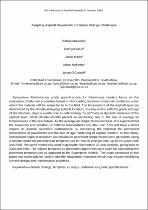JavaScript is disabled for your browser. Some features of this site may not work without it.
- ResearchSpace
- →
- Research Publications/Outputs
- →
- Conference Publications
- →
- View Item
| dc.contributor.author |
Mokoena, Refiloe

|
|
| dc.contributor.author |
Mturi, Georges AJ

|
|
| dc.contributor.author |
Maritz, Johan

|
|
| dc.contributor.author |
Malherbe, Johan

|
|
| dc.contributor.author |
O'Connell, Johannes S

|
|
| dc.date.accessioned | 2020-07-27T07:20:44Z | |
| dc.date.available | 2020-07-27T07:20:44Z | |
| dc.date.issued | 2019-10 | |
| dc.identifier.citation | Mokoena, R. et al. 2019. Adapting asphalt pavements to climate change challenges. In: 12th Conference on Asphalt Pavements for Southern Africa, Sun City, 13-16 October 2019 | en_US |
| dc.identifier.uri | https://www.capsa2019.co.za/wp-content/uploads/2019/11/Mokoena-et-al.pdf | |
| dc.identifier.uri | http://hdl.handle.net/10204/11519 | |
| dc.description | Presented in: 12th Conference on Asphalt Pavements for Southern Africa, Sun City, 13-16 October 2019 | en_US |
| dc.description.abstract | Performance grade specifications for bituminous binders focus on the evaluation of bitumen properties based on the loading and environmental conditions under which the material will be subjected to in the field. The temperature of the asphalt layer (as determined by the climate and geographical location), in conjunction with the grade and age of the bitumen, plays a pivotal role in determining the stiffness or dynamic modulus of the asphalt layer. Most climate models predict an increasing rate in the rise of average air temperatures in the near future. As the average air temperatures increase, it is expected that the frequency and duration of extreme temperatures will also rise. This will have a direct impact on asphalt pavement performance by increasing the potential for permanent deformation of pavements and the rate of age hardening of asphalt binders. In this study, interpolated maps of minimum and maximum pavement temperatures were generated using a climate model for predicted air temperatures for two 20-year periods, up to the years 2040 and 2060. The same model was used to generate two historic 20-year periods, going back to 2000 and 1980. The Viljoen temperature prediction algorithms were used for calculating the pavement temperatures as opposed to the Superpave models. The maps produced in this paper can eventually be used to identify adaptation measures which may include modifying current design and maintenance practices. | en_US |
| dc.language.iso | en | en_US |
| dc.publisher | CAPSA | en_US |
| dc.relation.ispartofseries | Workflow;23222 | |
| dc.subject | Asphalt pavements | en_US |
| dc.subject | Climate change | en_US |
| dc.subject | Performance grade specifications | en_US |
| dc.subject | Temperature maps | en_US |
| dc.title | Adapting asphalt pavements to climate change challenges | en_US |
| dc.type | Conference Presentation | en_US |
| dc.identifier.apacitation | Mokoena, R., Mturi, G. A., Maritz, J., Malherbe, J., & O'Connell, J. S. (2019). Adapting asphalt pavements to climate change challenges. CAPSA. http://hdl.handle.net/10204/11519 | en_ZA |
| dc.identifier.chicagocitation | Mokoena, Refiloe, Georges AJ Mturi, Johan Maritz, Johan Malherbe, and Johannes S O'Connell. "Adapting asphalt pavements to climate change challenges." (2019): http://hdl.handle.net/10204/11519 | en_ZA |
| dc.identifier.vancouvercitation | Mokoena R, Mturi GA, Maritz J, Malherbe J, O'Connell JS, Adapting asphalt pavements to climate change challenges; CAPSA; 2019. http://hdl.handle.net/10204/11519 . | en_ZA |
| dc.identifier.ris | TY - Conference Presentation AU - Mokoena, Refiloe AU - Mturi, Georges AJ AU - Maritz, Johan AU - Malherbe, Johan AU - O'Connell, Johannes S AB - Performance grade specifications for bituminous binders focus on the evaluation of bitumen properties based on the loading and environmental conditions under which the material will be subjected to in the field. The temperature of the asphalt layer (as determined by the climate and geographical location), in conjunction with the grade and age of the bitumen, plays a pivotal role in determining the stiffness or dynamic modulus of the asphalt layer. Most climate models predict an increasing rate in the rise of average air temperatures in the near future. As the average air temperatures increase, it is expected that the frequency and duration of extreme temperatures will also rise. This will have a direct impact on asphalt pavement performance by increasing the potential for permanent deformation of pavements and the rate of age hardening of asphalt binders. In this study, interpolated maps of minimum and maximum pavement temperatures were generated using a climate model for predicted air temperatures for two 20-year periods, up to the years 2040 and 2060. The same model was used to generate two historic 20-year periods, going back to 2000 and 1980. The Viljoen temperature prediction algorithms were used for calculating the pavement temperatures as opposed to the Superpave models. The maps produced in this paper can eventually be used to identify adaptation measures which may include modifying current design and maintenance practices. DA - 2019-10 DB - ResearchSpace DP - CSIR KW - Asphalt pavements KW - Climate change KW - Performance grade specifications KW - Temperature maps LK - https://researchspace.csir.co.za PY - 2019 T1 - Adapting asphalt pavements to climate change challenges TI - Adapting asphalt pavements to climate change challenges UR - http://hdl.handle.net/10204/11519 ER - | en_ZA |






